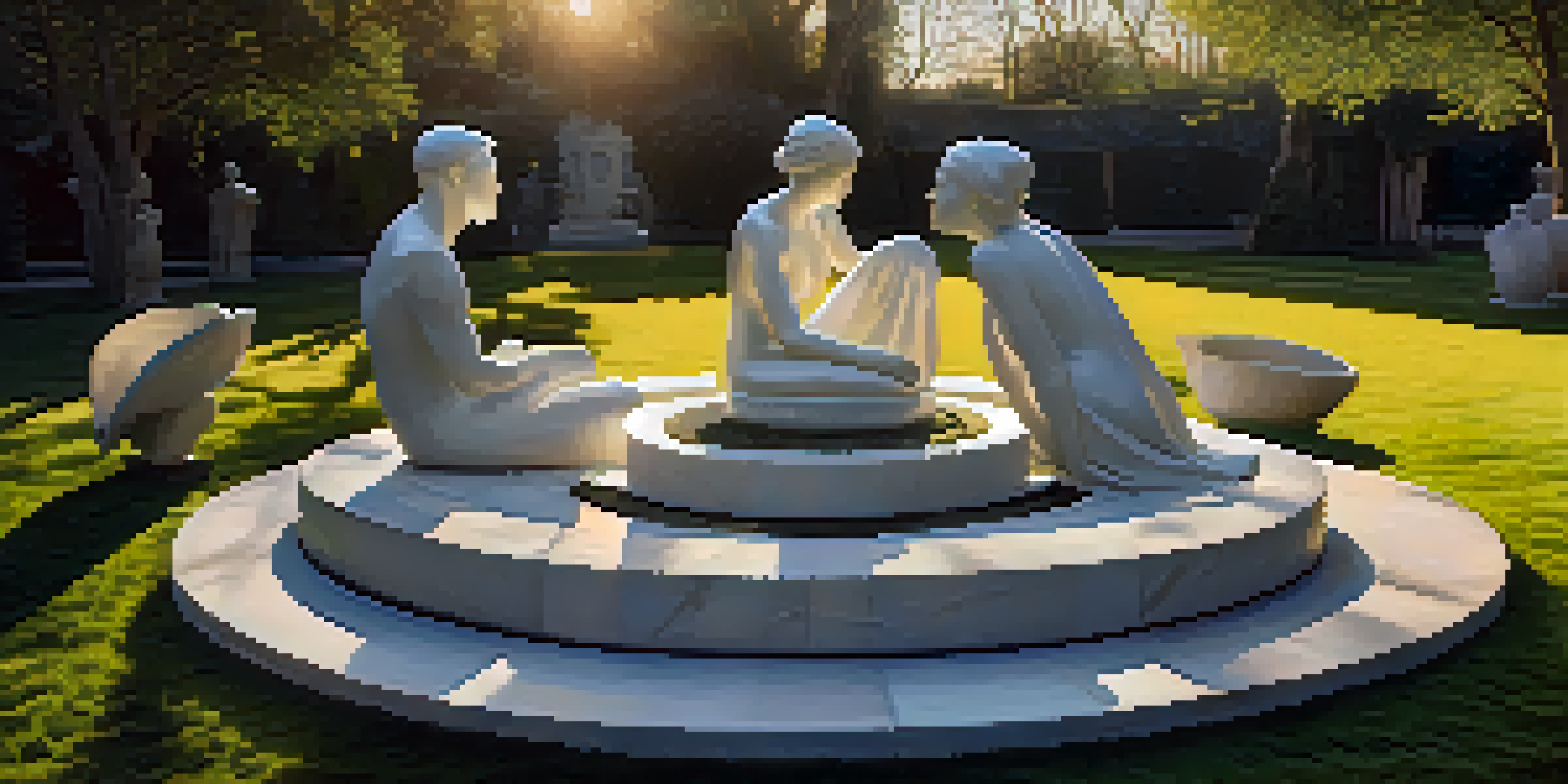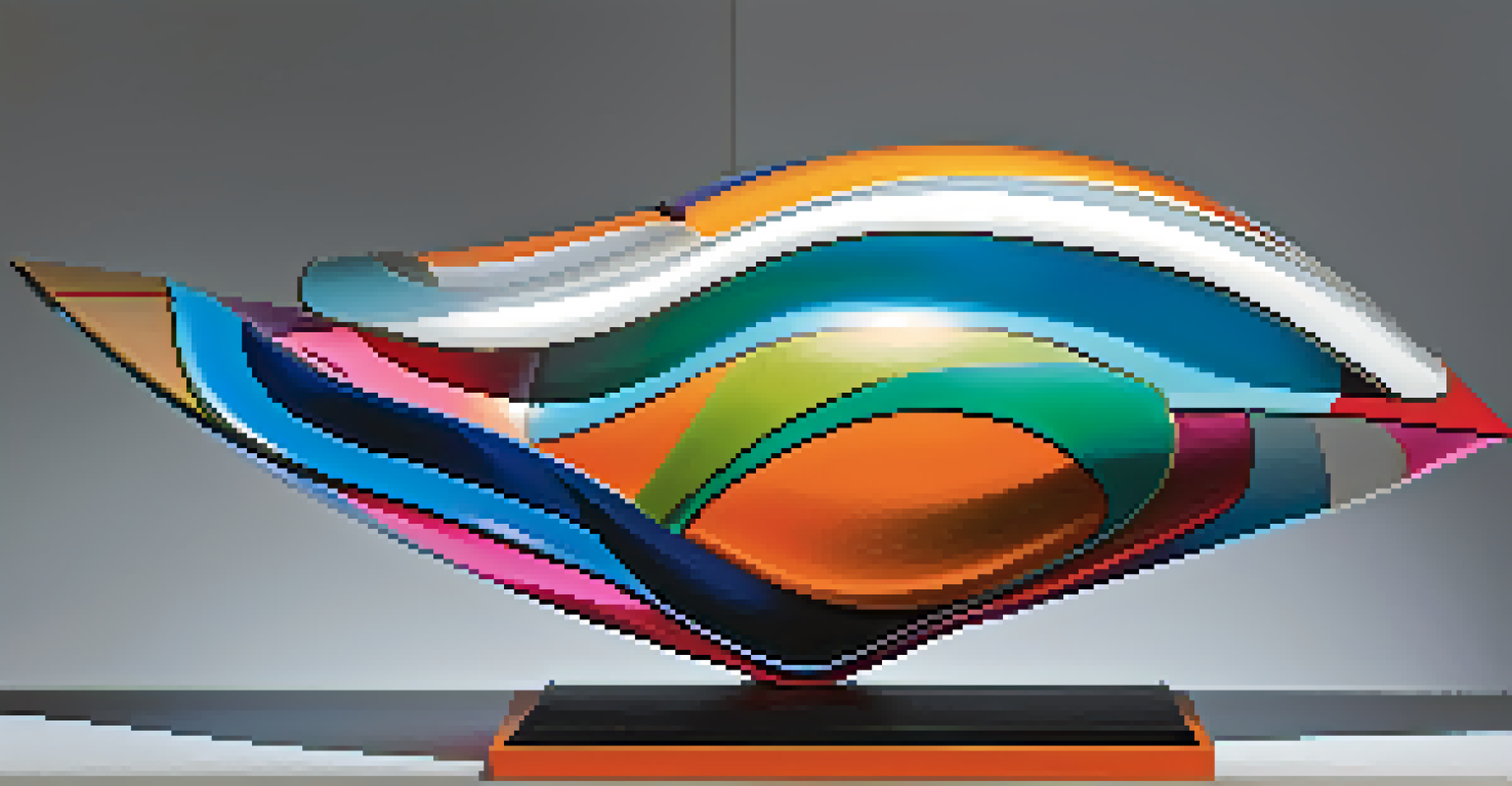Sculpture and Carving: A Comparative Look at Artistic Styles

Understanding Sculpture: An Overview of Its Forms
Sculpture is a fascinating art form that transcends mere aesthetics; it embodies culture, emotion, and history. It encompasses a variety of styles, including classical, modern, and contemporary, each with its unique characteristics. From the intricate details of Renaissance sculptures to the bold lines of modern abstract pieces, sculpture offers a visual narrative that invites interpretation.
Sculpture is the art of the intelligence.
One of the most captivating aspects of sculpture is its dimensionality. Unlike paintings or drawings that exist on a flat surface, sculptures occupy physical space, allowing viewers to engage with the artwork from multiple angles. This three-dimensional quality enhances the storytelling aspect, making the experience more immersive.
Moreover, the materials used in sculpture—such as marble, bronze, and wood—add another layer of depth to the artistic expression. Each medium carries its own history and techniques, influencing the final outcome. This variety encourages artists to select materials that resonate with their vision, further enriching the world of sculpture.
Carving: The Art of Subtracting Material
Carving is a specific technique within sculpture that involves removing material to create a desired form. It's akin to unearthing a hidden treasure from a solid block, where the artist's vision guides the process of subtraction. This meticulous approach requires patience and precision, as each cut can significantly alter the final piece.

Historically, carving has been employed in various cultures around the world, from ancient Egyptian reliefs to the intricate woodwork of Asian art. Each culture brings its own symbolism and techniques, resulting in a rich tapestry of styles. For instance, the smooth, flowing lines of Baroque carvings contrast sharply with the angular forms found in Gothic art, showcasing the diversity within this technique.
Sculpture's Emotional Power
Sculpture evokes deep emotions, allowing viewers to connect with the artwork on a visceral level.
The tactile nature of carved pieces invites a different kind of interaction. Viewers often feel compelled to touch and explore the textures, which can evoke a stronger emotional response compared to other forms of art. This sensory engagement highlights the unique power of carving in the realm of sculpture.
Comparing Styles: Classical vs. Contemporary Sculpture
Classical sculpture, often associated with ancient Greece and Rome, is renowned for its adherence to proportion, harmony, and idealized beauty. Artists like Michelangelo and Phidias focused on capturing the human form with incredible accuracy, resulting in timeless masterpieces. The emphasis on realism and the human experience laid the foundation for many artistic movements that followed.
The sculptor's hand is the hand of the artist, the sculptor's heart is the heart of the artist.
In contrast, contemporary sculpture embraces a wider array of styles and concepts, often challenging traditional notions of beauty and form. Artists today experiment with unconventional materials—such as found objects and digital media—breaking the boundaries established by their classical predecessors. This freedom allows for a broader exploration of themes like identity, technology, and social commentary.
The dialogue between classical and contemporary styles enriches the art world, as artists draw inspiration from the past while innovating for the future. This ongoing conversation invites audiences to appreciate the evolution of sculpture, where each style offers unique insights into the human experience.
Regional Influences on Sculpture and Carving Styles
Sculpture and carving are deeply influenced by the cultural and geographical contexts in which they are created. For example, African sculpture often reflects spiritual beliefs and communal values, using bold shapes and vibrant colors to convey messages. The region's rich traditions and materials inform the artistic choices, resulting in distinctive styles that celebrate heritage.
Similarly, Asian carving techniques, such as those seen in Chinese jade sculptures, emphasize intricate detail and symbolism. These pieces often tell stories or represent virtues, showcasing the artist's skill in manipulating the material to convey profound meanings. This focus on craftsmanship and narrative is a hallmark of many Asian cultures.
Impact of Technology on Art
Modern technology is transforming sculpture, enabling innovative forms and expanding accessibility for artists and audiences alike.
By examining regional influences, we can gain a deeper appreciation for the diversity within sculpture and carving. Each style serves not only as a form of artistic expression but also as a reflection of the values and stories of the people who create them.
The Role of Technology in Modern Sculpture
In recent years, technology has transformed the landscape of sculpture, opening up new possibilities for artists. Techniques such as 3D printing and digital modeling allow for unprecedented precision and experimentation. This fusion of art and technology challenges traditional methods, leading to innovative forms that might not be possible through conventional means.
Moreover, technology has also expanded the accessibility of sculpture. Artists can now share their work with a global audience through online platforms, reaching viewers who may never step foot in a gallery. This democratization of art fosters a vibrant community where ideas and styles can be exchanged freely, enriching the artistic discourse.
However, the integration of technology in sculpture also raises questions about authenticity and craftsmanship. As artists navigate this new terrain, they must find a balance between embracing technological advancements and preserving the hands-on techniques that have defined sculpture for centuries.
Emotional Impact: How Sculpture Moves Us
One of the most profound aspects of sculpture is its ability to evoke emotions. Whether it's the serene beauty of a classical figure or the provocative nature of contemporary installations, sculptures can resonate deeply with viewers. This emotional connection stems from the physicality of the medium, allowing us to engage with the work on a visceral level.
Take, for example, the haunting power of Auguste Rodin's 'The Thinker.' This iconic piece captures a moment of contemplation, inviting viewers to reflect on their own thoughts and feelings. The raw emotion conveyed through the sculptor's technique can resonate across time and cultures, highlighting the universal nature of human experience.
Cultural Influences on Styles
Sculpture and carving are shaped by regional cultures, reflecting the values and stories of the communities that create them.
Ultimately, the emotional impact of sculpture underscores its significance in our lives. It serves as a mirror reflecting our joys, struggles, and aspirations, reminding us of our shared humanity. This timeless connection between art and emotion is what continues to draw people to sculpture across generations.
The Future of Sculpture and Carving: Trends to Watch
As we look to the future, several trends are shaping the evolution of sculpture and carving. One notable trend is the increasing emphasis on sustainability and eco-friendly materials. Artists are exploring recycled and biodegradable materials, aligning their work with environmental consciousness and societal values.
Another trend is the blending of various artistic disciplines. Sculptors are collaborating with painters, digital artists, and performers to create multi-dimensional experiences that transcend traditional boundaries. This interdisciplinary approach fosters innovation and invites audiences to engage with art in new and exciting ways.

Finally, the rise of virtual and augmented reality is poised to revolutionize how we experience sculpture. Imagine walking through a digital gallery, interacting with sculptures that change shape and color as you move closer. This immersive experience not only captivates viewers but also expands the definition of what sculpture can be, paving the way for endless possibilities.